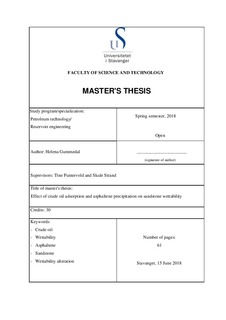| dc.description.abstract | Wettability is an important property for oil recovery. It affects capillary pressure and controls fluids, location, and flow in the reservoir. By an increase in capillary pressure (due to increased water wetness), previously non-swept pores can be displaced and therefore residual oil saturation will be reduced which increase oil recovery. As such, the alteration of wettability can be used as an EOR method. The injection of Smart Water is one such method that for sandstone rock will be a form for low salinity flooding. For this method to work, the mineralogy of the sandstone is very important as it affects the wettability greatly. The negative rock surface of sandstone, mainly due to clay minerals and their cation exchange capacity, will lead to the adsorption of polar components in slightly acidic environment. Other important parameters that affect wettability are formation water (its composition, pH, and salinity), crude oil, temperature, pressure, COBR interactions, initial water saturation and core restoration.
Crude oil is a complex mixture of many different components, where those components that consist of nitrogen, sulfur or oxygen are associated with polarity. A general division is: oil (saturates and aromatics), resins and asphaltenes. Asphaltenes and resins are the heavier fraction consisting of polar components, where asphaltene is generally accepted to affect wettability the most. They can either be adsorbed onto the rock surface or precipitated from the crude oil. Asphaltene precipitation will change the wetting towards oil-wet conditions, which can be difficult to reverse. However, polar components of acidic and basic nature can also affect wettability by adsorption. Desorption of organic polar components from rock surfaces changes the wetting towards more water-wet conditions (increased by injection of Smart Water; low salinity water).
Asphaltenes have been shown by studies to be responsible for mixed-wet rock. Still, it is not necessary for asphaltenic content for this to occur. Smaller molecules, such as the weak base quinoline, are also capable of altering the wettability by adsorption and making a mixed-wet rock. | nb_NO |

